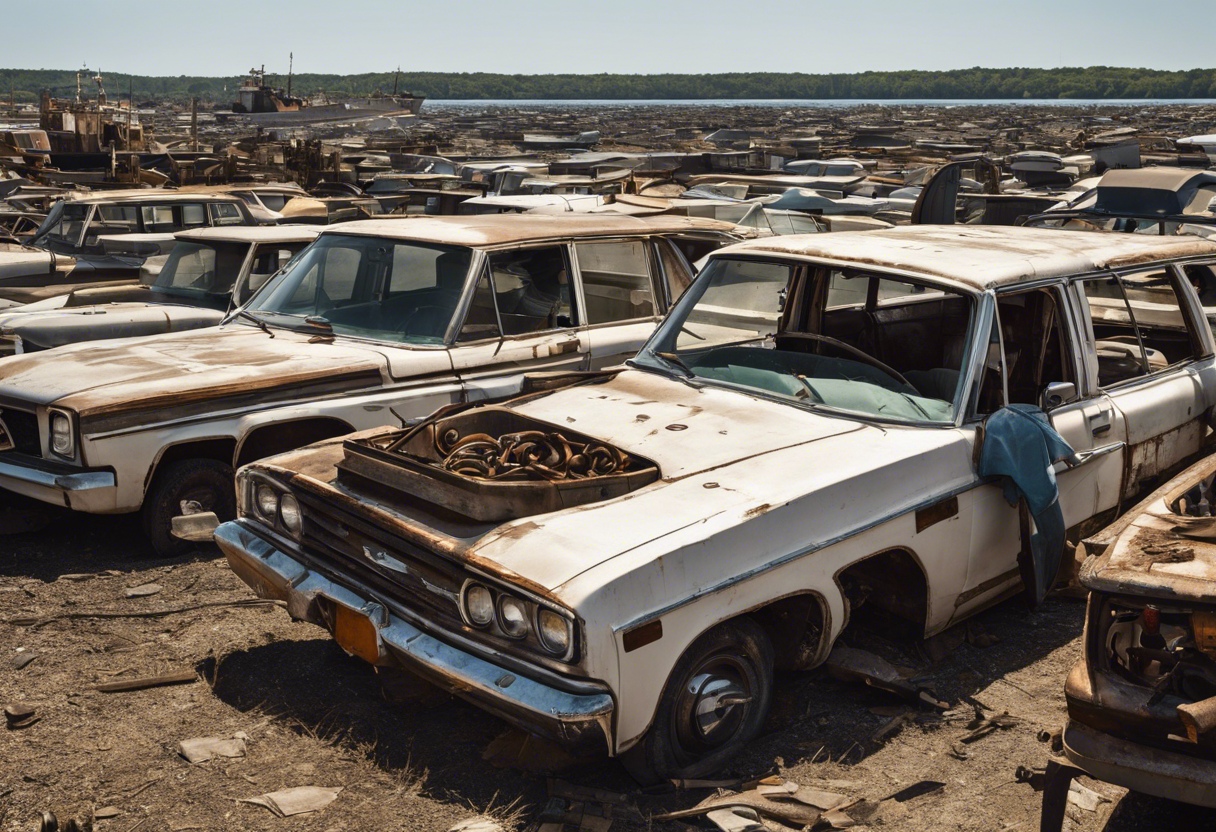![]() Introduction
Introduction
Boat salvage yards are treasure troves for mariners, hobbyists, and restorers. Salvage Yard of maritime history offer a sustainable way to reclaim boat parts, reduce waste, and conserve the valuable resources that would otherwise be lost. They harbor a multitude of vessels, from leisure crafts to commercial boats, each holding a potential wealth of usable components. Savvy navigators of salvage yards can uncover rare finds, economical replacements, and authentic pieces to restore boats to their former glory. As one delves into the world of boat salvage, the opportunities are as vast as the seas themselves, revealing a profound potential beneath the rust and timber of docked sea-faring relics.
Preparation for the Treasure Hunt:
Tools and Safety Measures
When launching an expedition to a boat salvage yard, mariners must equip themselves with the proper tools and prioritize safety. Essential gear includes:
- Sturdy gloves: to protect hands from sharp objects and hazardous materials.
- Durable footwear: to ensure stable footing among debris.
- High-visibility clothing: to be easily spotted among the yard’s hazards.
- A flashlight or headlamp: for visibility in low-light conditions.
- A magnet and metal detector: to locate hidden metal treasures.
- Cutting tools: such as saws and bolt cutters, for extracting items.
Safety measures are paramount. Mariners should:
- Adhere to yard rules: to maintain an orderly and safe environment.
- Avoid overexertion: to prevent physical strain or injury.
- Stay hydrated: to combat fatigue and heat-related illnesses.
- Use a buddy system: to ensure help is readily available in case of emergency.
Understanding Salvage Yard Rights:
Legal Considerations Before Diving In
Before delving into boat salvage endeavors, understanding the intricacies of salvage rights is crucial. Individuals must recognize that:
- Salvaged goods often fall under maritime law, which differs significantly from common law.
- Identifying ownership and obtaining proper authorization to salvage is mandatory to avoid legal penalties.
- Maritime salvage rights vary by jurisdiction but generally reward those who aid in recovering property without owner presence.
- The doctrine of “finders, keepers” rarely applies; salvors must typically return the property to its rightful owner after rescue.
- Written agreements detailing the salvage operation, compensation, and contingency arrangements help prevent future disputes.
Legal advice is essential to navigate these complexities and protect one’s interests while partaking in salvage operations.
Scouring the Salvage Yards:
Effective Strategies to Identify Valuable Finds
When visiting boat salvage yards, it’s important to employ effective strategies to spot worthwhile items:
-
Research: Understand common boat parts’ value before arriving.
-
Make Connections: Befriend yard staff for insider knowledge.
-
Inspect Thoroughly: Look for items in good condition or with minor fixable damages.
-
Frequent Visits: Inventory changes regularly, so visit often.
-
Carry Tools: Bring necessary tools to extract parts without damaging them.
-
Know Your Project: Have a list of specific needs for your boat to avoid unnecessary purchases.
-
Negotiate: Learn to negotiate prices, as yard owners often set flexible rates.
-
Stay Patient: Finding treasures requires time and persistence; don’t rush your search.
Material Worth:
Identifying the Most Sought-After Items in Boat Salvage Yard
In boat salvage yards, certain items hold particularly high value due to their durability, rarity, or essential function.
-
Marine Electronics: Navigation systems, radars, and fish finders are coveted for their high-tech capabilities.
-
Engines and Parts: Outboard motors, especially from reputable brands, are sought-after for their horsepower and reliability.
-
Hardware and Fittings: Stainless steel fittings, cleats, and rigging equipment withstand harsh marine environments, making them valuable finds.
-
Sails: Good condition sails, especially spinnakers or genoas, can be a cost-effective treasure for sailors.
-
Deck Gear: Winches, blocks, and anchors are essential for any vessel and often found in good working order.
-
Interior Amenities: Items like marine stoves, refrigeration systems, and quality woodwork can be refurbished and reused, offering significant savings.
These components, when found in salvageable condition, can significantly reduce maintenance and upgrade costs for mariners.
The Art of Negotiation:
Tips for Pricing and Purchasing Salvaged Treasures
When exploring boat salvage yards, mariners should approach negotiations with finesse and knowledge. Consider these tips:
-
Research Market Value: Before engaging, research the current market value of items to establish a realistic price range.
-
Assess Condition: Physically inspect the item for defects or wear that could affect its value. Use this assessment during negotiation.
-
Articulate Value: Clearly communicate why the piece is valuable to you. A shared understanding can facilitate a better deal.
-
Be Patient: Hastiness can lead to overspending. Show interest, but don’t fear walking away if terms don’t favor you.
-
Consider Bundle Deals: Purchasing multiple items might lead to discounts.
-
Politeness Pays Off: A pleasant demeanor during negotiation can create a positive seller-buyer relationship, possibly resulting in better pricing.
Remember, every salvaged piece has a story – its value often lies beyond the price tag.
Restoration Possibilities:
From Salvage Yard to Seaworthy
Venturing into boat salvage yards, the resourceful mariner discovers a realm of potential. Amidst the seemingly forlorn vessels and nautical cast-offs, lies the opportunity to breathe new life into derelict hulls. Restoration, a journey from salvage to seaworthy, encompasses:
- Evaluating structural integrity, crucial for a vessel’s seaworthiness.
- Sourcing authentic or compatible parts, often found at a fraction of new costs.
- Employing skilled craftsmanship in woodworking, fiberglass repair, or metalwork.
- Upgrading electrical systems, ensuring modern functionality and safety.
- Applying aesthetic touches that reflect the personal style of the boat owner.
Every salvaged boat holds a story; with dedication and skill, mariners can rewrite its destiny from abandoned to admired.
Repurposing Nautical Relics:
Creative Ideas for Upcycling Boat Parts
Transforming old nautical components into functional art merges maritime history with sustainability. Ingeniously, weathered ship wheels evolve into chic coffee table bases. Brass portholes are repurposed as striking picture frames, embedding a hint of the sea into home decor. Another idea is to convert old sails into durable tote bags or outdoor canopies, giving them a second wind. Salvaged wooden hull planks can become rustic shelving or unique bar countertops, infusing nautical charm into spaces. Boat propellers also make for impressive wall hangings or garden sculptures, adding a touch of intrigue to any environment.
Environmental Considerations:
Responsible Salvaging for a Sustainable Future
Boat salvage yards offer more than just economical benefits for mariners seeking parts; they are pivotal in promoting environmental sustainability. These facilities prevent potentially hazardous materials from entering landfills and waterways by recycling components from defunct vessels.
-
Chemical Management: Proper disposal of oils, fuels, and batteries is critical, as they can be detrimental to ecosystems.
-
Material Reuse: Repurposing materials like metals, woods, and plastics reduces the strain on natural resources and minimizes the carbon footprint.
-
Wildlife Protection: Careful handling and disposal protect local fauna from harm.
-
Regulation Compliance: Salvage yards must adhere to stringent environmental laws, ensuring operations align with conservation principles.
By prioritizing environmental protection, responsible salvaging supports a sustainable future, balancing maritime interests with ecological preservation.
Learning from the Professionals:
Insights from Experienced Salvagers
Experienced salvagers stress the importance of preparation before venturing into boat salvage yards. They recommend:
- Familiarizing oneself with the specific parts needed and the models they belong to.
- Carrying necessary tools to safely remove and transport parts.
- Establishing relationships with yard owners for better access to incoming inventory.
- Understanding the history and condition of the vessels to evaluate the quality of parts.
- Learning the environmental regulations concerning the salvaging process to avoid legal issues.
The wisdom they share is invaluable for maximizing the potential of each salvage foray while minimizing risks and costs.
Networking in the Nautical Community:
Building Relationships with Yard Owners and Fellow Salvage Yard Enthusiasts
Success in the marine salvage environment often hinges on strong community connections. Mariners can enhance these connections by:
- Joining local boating clubs and forums to engage with like-minded enthusiasts.
- Attending boat shows and auctions to meet yard owners and discuss potential partnerships.
- Offering to help with restoration projects to demonstrate commitment and gain yard access.
Regular communication is pivotal. Whether swapping stories or sharing technical advice, these interactions lay the groundwork for mutual respect and future collaboration. By fostering goodwill with yard owners, salvage treasure hunters may receive tips on new arrivals or rare finds. Similarly, exchanging information with fellow salvage aficionados can lead to shared opportunities and deeper insights into the ebb and flow of the boat salvage world.
Showcasing Your Finds:
Best Practices for Documenting and Sharing Your Salvage Yard Adventures
In the realm of boat salvage yards, documenting and sharing findings is paramount. Enthusiasts should:
-
Photograph extensively: Take pictures from multiple angles to capture the condition and uniqueness.
-
Record details: Note model numbers, manufacturers, and dimensions—vital for authenticity and resale.
-
Maintain a log: Keep a journal detailing the salvage process, including dates and locations.
-
Use social media wisely: Share your adventures on platforms frequented by fellow mariners and collectors.
-
Create a blog or vlog: Provide a narrative about your salvaging journey, tips, and restoration processes.
Consistent sharing not only fosters community but also establishes credibility as a seasoned salvager.

Conclusion:
The Rewarding Journey of Boat Salvage Yard Exploration
Exploring boat salvage yards is not just a quest for parts and equipment; it’s a voyage into the heart of nautical history. Each corroded piece, every weathered deck, tells a story of adventures across the waves and the secrets of the deep. Mariners who navigate these repositories of maritime lore can unearth not only valuable items for their vessels but also enrich their appreciation for seafaring heritage. With patience, expertise, and respect for the past, the journey through boat salvage yards can be as rewarding as the treasures they conceal.
FAQs (Frequently Asked Questions) About Salvage Yard
read more: Exploring the Vast Selection at CarGiant
read more: What is the point of salvage/junk yards …

